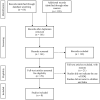Parents' Evaluation of Developmental Status and Strength and Difficulties Questionnaire as Screening Measures for Children in India: A Scoping Review
- PMID: 36976721
- PMCID: PMC10055800
- DOI: 10.3390/pediatric15010014
Parents' Evaluation of Developmental Status and Strength and Difficulties Questionnaire as Screening Measures for Children in India: A Scoping Review
Abstract
Due to the limited availability of suitable measures, screening children for developmental delays and social-emotional learning has long been a challenge in India. This scoping review examined the use of the Parents' Evaluation of Developmental Status (PEDS), PEDS: Developmental Milestones (PEDS:DM), and the Strength and Difficulties Questionnaire (SDQ) with children (<13 years old) in India. The scoping review was conducted following the Joanna Briggs Institute Protocol to identify primary research studies that examined the use of the PEDS, PEDS:DM, and SDQ in India between 1990 and 2020. A total of seven studies for the PEDS and eight studies for the SDQ were identified for inclusion in the review. There were no studies using the PEDS:DM. Two empirical studies used the PEDS, while seven empirical studies used the SDQ. This review represents the first step in understanding the use of screening tools with children in India.
Keywords: India; PEDS; SDQ; children; scoping review; screening.
Conflict of interest statement
The authors declare no conflict of interest.
Figures
Similar articles
-
Screening Children in India: Translation and Psychometric Evaluation of the Parents' Evaluation of Developmental Status and the Strength and Difficulties Questionnaire.Pediatr Rep. 2023 Dec 14;15(4):750-765. doi: 10.3390/pediatric15040067. Pediatr Rep. 2023. PMID: 38133435 Free PMC article.
-
The Use of the Parents' Evaluation of Developmental Status and Developmental Milestones in Screening Children for Developmental Delay in India.Children (Basel). 2024 Dec 18;11(12):1530. doi: 10.3390/children11121530. Children (Basel). 2024. PMID: 39767959 Free PMC article.
-
Diagnostic Accuracy of Parents' Evaluation of Developmental Status (PEDS), PEDS Developmental Milestones, and PEDS Combined in Indian Children Aged Less than 2 Years.Indian J Pediatr. 2022 May;89(5):459-465. doi: 10.1007/s12098-020-03651-y. Epub 2021 Feb 23. Indian J Pediatr. 2022. PMID: 33620632
-
Predictive Validity of Developmental Screening Questionnaires for Identifying Children With Later Cognitive or Educational Difficulties: A Systematic Review.Front Pediatr. 2021 Nov 24;9:698549. doi: 10.3389/fped.2021.698549. eCollection 2021. Front Pediatr. 2021. PMID: 34900855 Free PMC article.
-
The Strengths and Difficulties Questionnaire (SDQ) in Africa: a scoping review of its application and validation.Child Adolesc Psychiatry Ment Health. 2018 Jan 11;12:6. doi: 10.1186/s13034-017-0212-1. eCollection 2018. Child Adolesc Psychiatry Ment Health. 2018. PMID: 29344084 Free PMC article.
Cited by
-
Screening Children in India: Translation and Psychometric Evaluation of the Parents' Evaluation of Developmental Status and the Strength and Difficulties Questionnaire.Pediatr Rep. 2023 Dec 14;15(4):750-765. doi: 10.3390/pediatric15040067. Pediatr Rep. 2023. PMID: 38133435 Free PMC article.
-
The Use of the Parents' Evaluation of Developmental Status and Developmental Milestones in Screening Children for Developmental Delay in India.Children (Basel). 2024 Dec 18;11(12):1530. doi: 10.3390/children11121530. Children (Basel). 2024. PMID: 39767959 Free PMC article.
-
Protocol of the Nutritional, Psychosocial, and Environmental Determinants of Neurodevelopment and Child Mental Health (COINCIDE) study.Wellcome Open Res. 2024 Nov 22;9:486. doi: 10.12688/wellcomeopenres.22817.2. eCollection 2024. Wellcome Open Res. 2024. PMID: 39882387 Free PMC article.
-
A systematic compilation of rating scales developed, translated, and adapted in India.Indian J Psychiatry. 2024 Sep;66(9):767-787. doi: 10.4103/indianjpsychiatry.indianjpsychiatry_467_24. Epub 2024 Sep 19. Indian J Psychiatry. 2024. PMID: 39502591 Free PMC article. Review.
-
Unraveling the Spectrum: A Comprehensive Review of Autism Spectrum Disorder in India.Cureus. 2024 Jun 20;16(6):e62753. doi: 10.7759/cureus.62753. eCollection 2024 Jun. Cureus. 2024. PMID: 39036210 Free PMC article. Review.
References
-
- American Psychiatric Association . Diagnostic and Statistical Manual of Mental Disorders (DSM-5-TR) 5th ed. American Psychiatric Association Publishing; Washington, DC, USA: 2022.
-
- International Classification of Diseases, Eleventh Revision (ICD-11) World Health Organization; Geneva, Switzerland: 2021. [(accessed on 9 November 2021)]. Available online: https://icd.who.int/browse11/lm/en#/http%3a%2f%2fid.who.int%2ficd%2fenti....
-
- Denham S.A., Brown C. “Plays Nice with Others”: Social-Emotional Learning and Academic Success. Early Educ. Dev. 2010;21:652–680. doi: 10.1080/10409289.2010.497450. - DOI
Publication types
LinkOut - more resources
Full Text Sources



